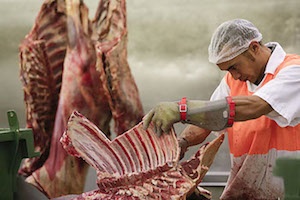Vietnam: Problems with US meat exports due to high tariffs

Tariff differences affect US competitiveness
US beef exports to Vietnam are subject to most-favored-nation (MFN) tariffs, which are significantly higher than those of countries participating in the Comprehensive and Progressive Agreement for Trans-Pacific Partnership (CPTPP) and other free trade agreements. For example, frozen pork from the US is subject to a 10% MFN tariff, while CPTPP members such as CANADA and Mexico enjoy zero tariffs.
Similarly, US beef imports may be subject to duties of up to 30%, while Australian and New Zealand beef enters Vietnam duty-free under existing agreements.
Vietnam's MEAT import market is expanding and experiencing significant growth, driven by urbanization, rising incomes, and a growing middle class seeking high-quality and processed meat products. In 2024 , the country imported approximately 876,670 tons of meat and meat products worth US$1.78 billion, an 18.1% increase compared to 2023. India remains the largest supplier, accounting for over 22% of total imports, followed by Brazil and RUSSIA .
US Industrial Efforts and Strategic Positioning
To address these issues, American industry groups like the United States Meat EXPORT Federation (USMEF) are focusing on trade promotion, consumer-focused marketing, and supporting Vietnamese importers through training and incentives. They emphasize the superior quality and safety of American beef, produced according to strict standards and modern inspection systems. The grain-based feed used in American livestock production also produces meat that meets Vietnamese consumers' preferences for tenderness and flavor.
The recent imposition of a 46 percent tariff on Vietnamese products by the United States has created significant tensions in trade relations with the United States, threatening Vietnam's export-driven economy and complicating bilateral relations. Key Vietnamese export sectors, such as electronics, textiles, footwear, and furniture, are particularly vulnerable, as the United States is their primary market, and these products currently face significant price disadvantages.
The tariff is five times higher than Vietnam's average import tax on US goods, highlighting the imbalance and heightening tensions. President Trump previously announced a temporary 90-day suspension of the tariff, reducing it from 46% to 10%, while both sides seek a longer-term agreement. Vietnam has also proposed lowering duties on US imports and promised to address concerns about the transit of Chinese goods through its territory. Despite these efforts, the uncertainty has already disrupted supply chains, jeopardized jobs, and raised concerns about global economic stability.
A look into the future
As Vietnam continues to negotiate and implement trade agreements, the US meat industry is pushing for tariff reductions and more favorable trade terms to remain competitive and meet growing demand in this dynamic market. Participating in future trade negotiations and exploring potential free trade agreements could be crucial for US exporters seeking to strengthen their presence in Vietnam's growing meat market.
Read together with it:
- Belstat reported how much grain, milk, meat, and vegetables are produced in Belarus per capita.November 14, MINSK . Belarus produces 913 kg of grain, 958 kg of MILK, 341 kg of potatoes, and 304 kg of vegetables per capita, according to a review by the National Statistical Committee for the Day of Agricultural and Processing Industry Workers, BELTA reports. The country also produces 78 kg of fruits and berries, 147 kg of livestock and poultry (slaughter weight), and 4......
- The IEA sees a risk of a decline in oil production in Russia due to sanctions.The IEA sees a risk of reduced oil production in RUSSIA due to US sanctions , but maintains its production forecast. According to the IEA, Russian oil exports will remain unchanged.There is a "significant downside risk" to Russia's oil production forecast due to US sanctions, the International Energy Agency (IEA) said in a report.BLOOMBERG . The agency's experts believe that the latest US sanction...
- UniCredit заявил о галактических усилиях из-за санкций против РоссииUniCredit старается не нарушить «более 15 тыс. санкций», а также не «совершать ошибки», которые позволят изъять его активы в России, заявил гендиректор. После начала военной операции банк начал рассматривать возможность ухода Итальянский банк UniCredit прилагает «галактические усилия», пытаясь соблюсти международные санкции в отношении своего российского подразделения. Об этом заявил генеральный д...
- "Коллективы АПК способны решать любые задачи даже в непростых условиях". Назаров о заслугах сельхозпроизводителейЮрий Назаров 13 ноября, Минск. Обеспечение продовольственной безопасности страны - большое достижение трудовых коллективов аграриев, отметил управляющий делами Президента Республики Беларусь Юрий Назаров на торжественной церемонии награждения государственными и иными наградами работников АПК Управления делами Президента Республики Беларусь, передает корреспондент БЕЛТА. Торжественная церемония наг...
- Russian agriculture: self-sufficiency continues to growThe industry has a track record of implementing new technologies and increasing productivity. RUSSIA is already confidently self-sufficient in grain, MEAT, fish, vegetable oil, and SUGAR. Grain and vegetable production is also forecast to be higher this year, despite unfavorable weather conditions in some regions. The Ministry expects historic highs for some crops and continues to support agricult...


